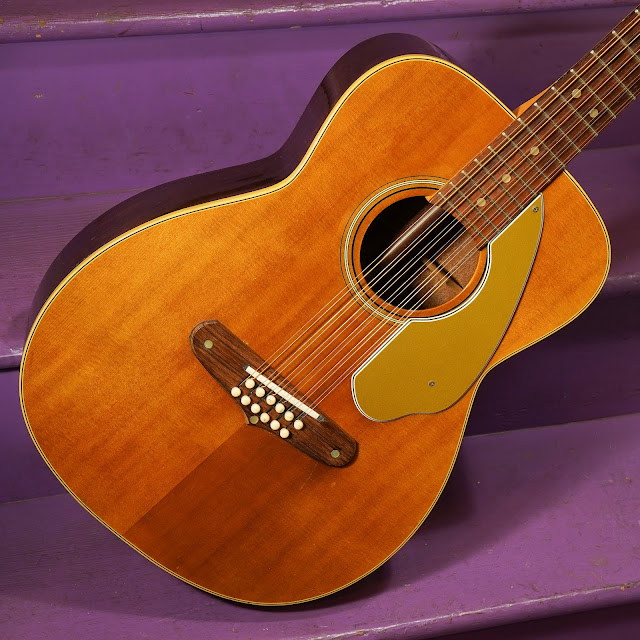1966 Fender Villager 12-String Guitar
Update October '22: This guy is back here for resale so I've updated the post...
This old beaut has a sort-of punchy, zippy, stinging-in-the-mids sound. It's a bit like listening to the compressed Tom Petty 12-string recording sound but without having to stick a mic in front of it and punch it down in the studio. It's a perfect sound for jingle-jangle chord-banging and strumming but not as great a tone if you're planning to do beautiful Leo Kottke-style stuff and want full-range bass and mellow trebles.
What's nice about these Villager 12s is that the necks feel like a slightly-oversize Strat neck from the period -- they're comfortable and fast and fun to play, especially if you like to do sliding chord shapes up and down the neck.
Being an early Villager (the neck plate says '65 but as I recall it has a '66 stamp at the neckblock), it features the big old aluminum rod stuffed through the center of the body. This is a plus, though, because it keeps the guitar and its neck joint nice and stable. Later Villagers (without the rod) can be fussy as the neck joint wants to wander under tension and so the setups need to sometimes be adjusted on them more often than you'd want.
The guitar itself is all-original save the saddle and the dots on the bridge, has cool old Fender "F" Schaller tuners, a solid spruce top (x-braced but with a tighter x-pattern that gives these their own, mids-forward sound), solid mahogany back and sides, maple neck, rosewood board and bridge, and 000-size dimensions.
People complain up and down about these old Fender bolt-on acoustics on forums but that's mostly because folks haven't played ones that have been "ironed-out" properly. They're great-playing, interesting-sounding animals once they've been dialed-in but they can be completely useless if they haven't been adjusted and setup well. My $0.02 on these, though, is to always look for the early models with the metal rod running through the body.
Post-repairs, this guy is playing fast, easy, and spot-on and is ready to go.
Repairs included: a fret level/dress, bridge reglue, new fully-compensated bone saddle, string-ramp slots on the bridge for better down-pressure on the saddle, cleaning, and setup work. I have 46w-10 guages on this and I suggest that as the heaviest for use with E-to-E standard tuning.
Top wood: solid spruce
Back & sides wood: solid mahogany
Bracing type: x
Bridge: rosewood
Fretboard: rosewood
Neck wood: maple
Action height at 12th fret: hair-under 3/32” bass 1/16” treble (fast, spot-on)
String gauges: 46w-10 extra lights
Neck shape: slim-medium C
Board radius: 7 1/4"
Truss rod: adjustable
Neck relief: straight
Fret style: medium-low
Scale length: 25 1/2"
Nut width: 1 3/4"
Body width: 14 7/8"
Body depth: 3 7/8"
Weight: 6 lbs 0 oz
Condition notes: aside from the saddle, string ramps, and replacement dots (they used to hide bridge bolts) at the bridge, the guitar is otherwise completely original. It's nice to have that gold pickguard intact and the rosette still un-chewed-up, too. It definitely has the usual wear and tear by way of small scratches, nicks, and dings throughout the finish but overall it looks good. There's some hairline cracking to the finish on the top, which is completely normal for these. They all have it as far as I know. It's only in the finish, though, on this guy. The worst part of this guitar is that, like usual, it has the "Villager hump" around the bridge -- bellying. My bridge reglue helped a lot of that but it's still evident. It's been stable since restringing after the bridge work so I don't expect it'll be a problem, but I did take a photo from the side to show what it looks like.
It comes with: its original Victoria Luggage Company hard case!






















Comments